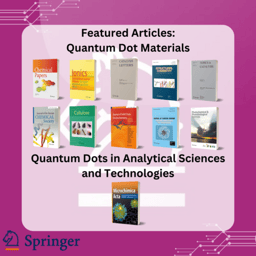From quantum dots to carbon dots and beyond: synthesis, characterization and (bio)analytical applications

Explore the Research

From quantum dots to carbon dots and beyond: synthesis, characterization, and (bio)analytical applications - Microchimica Acta
Graphical Abstract
Also on behalf of the Editors-in-Chief of Microchimica Acta, Alberto Escarpa and Mamas I. Prodromidis, as well as the Guest Editors, Constantine D. Stalikas and Jose M. Costa-Fernandez, I am pleased to share that the Topical Collection From quantum dots to carbon dots and beyond: synthesis, characterization and (bio)analytical applications has recently been completed.
Follow the Topic
-
Microchimica Acta

As a peer-reviewed journal for analytical sciences and technologies on the micro- and nanoscale, Microchimica Acta has established itself as a premier forum for truly novel approaches in chemical and biochemical analysis.
Related Collections
With Collections, you can get published faster and increase your visibility.
Eco-friendly Micro- and Nanomaterials and Interfaces in the Realm of Green and White Analytical Chemistry: From Conceptualization to Synthesis and Applications
The growing emphasis on environmental and human health has led to sustainable practices in analytical chemistry. In the realm of Green and White Analytical Chemistry (GAC-WAC), a diverse array of eco-friendly micro- and nanomaterials has been developed, aligning with key principles of green chemistry and high analytical performance. These eco-friendly materials are distinguished by their sustainability and low environmental impact. They reflect a paradigm shift toward greener, cleaner and ethically sound analytical approaches, with applications in diverse fields.
This topical collection focuses on conceptualization, synthesis and applications of eco-friendly micro- and nanomaterials and functional composites that address the dual challenge of achieving high analytical performance while minimizing environmental footprint, thereby contributing towards sustainable analytical workflow. It seeks to bridge the gap between green material science and analytical innovations by promoting the engineering of materials/composites that deliver high analytical performance while ensuring safety, resource efficiency and sustainability. Contributions, reflecting a system-level understanding of analytical outcomes influenced by micro- and nanomaterials in line with GAC and WAC paradigms, are highly encouraged.
Publishing Model: Hybrid
Deadline: Jul 31, 2026
Wearable Sensors in Precision Agriculture
This topical collection aims to gather cross-cutting research at the intersection of precision agriculture and wearable sensing technologies. Focusing on wearable sensing technologies, it highlights innovative fabrication of nanomaterials and devices to address detection needs in precision agriculture. Wearable energy-harvesting devices, capable of providing continuous power for sensors, help alleviate concerns about energy supply. Specific themes include, but are not limited to: Health biomarker detection and evaluation: Wearable sensors for plant/animal stress biomarkers (e.g., volatile organic compounds, hormones).
Growth dynamics monitoring: Wearable systems for real-time tracking of nutrient uptake, growth states (via motion capture), and environmental adaptability in crops and livestock.
Self-powered sensing systems: Wearable energy-harvesting technologies (e.g., biofuel cells, solar energy) to ensure long-term wireless operation of sensors in agricultural settings.
Agricultural product safety and quality assurance: Edible/wearable sensors attached to food surfaces for real-time monitoring of freshness, flavor, and contamination risks.
Livestock transportation monitoring: Wearable devices for continuous tracking of vital signs (e.g., body temperature, heart rate) in live animals, reducing losses during transport.
Publishing Model: Hybrid
Deadline: Sep 01, 2026

Please sign in or register for FREE
If you are a registered user on Research Communities by Springer Nature, please sign in